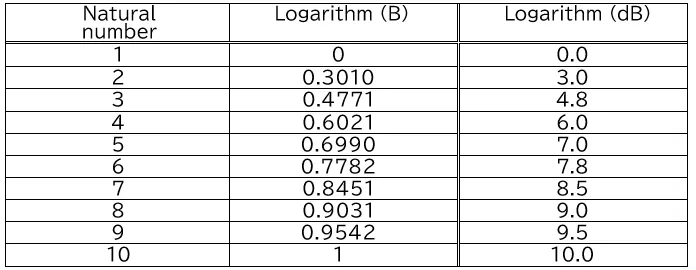No.7 Various measurement instrument: What is dB? (Part 2)
In the previous column, I explained that dB (decibel) and B (bell) are comparative expression of electric power in logarithm (common logarithm). In this column, I will explain why dB came to have the SI prefix d (deci), and the power gain and voltage gain of dB.
1) Why dB came to have the SI prefix d (deci)?
As explained in the previous column, B (bell) is a logarithmic quantity of the ratio of reference physical quantity to measured physical quantity. For example, if the measured value is 10 times the reference value, it is 101, so 1B (1 bell), if it is 100 times, it is 102, so it is 2B (2 bell), and if it is 1/10 times, it is 10-1, so it is -1B (-1 bell). However, the actual measured value is not only an exact number, but also a number that is twice or five times the reference value. Thus, as shown in Table 1, when it is expressed in logarithm, it has fractions after the decimal point.
Table 1. Natural number and common logarithm

1 times (0B) and 10 times (1B) of the reference value are exact numbers without fractions, but 2 to 9 times are numbers with fractions after the decimal point as described above. In the table above, 2 times is about 0.3 B, 4 times is about 0.6 B, 5 times is about 0.7 B, and 8 times is about 0.9 B. The above antilogarithms*1 represent more than 1 time, however, when you look at the corresponding B (bell) value, you might think it is less than 1 time. Therefore, it was considered to multiply the B (bell) value by 10 times by adding d (deci) so that the value corresponding to 1 to 10 times, which are relatively frequently used, become 1 or more. When the value of B is expressed in dB, 2 times is about 3 dB, 4 times is about 6 dB, 5 times is about 7 dB, and 8 times is about 9 dB. From the above reason, dB (decibel) which the SI prefix d (deci) is added to B has come to be used.
*1: An antilogarithm is the x of the logarithm logax. Table 1 shows antilogarithms as natural numbers.
2) Power gain and voltage gain
Gain is the ratio of input to output in an electrical circuit. The quantity is either power, voltage, or current, and is called power gain, voltage gain, or current gain, respectively.
Although it is sometimes expressed as n times as the unit of gain, dB (decibel) is more often used. Thus, I will explain about this in this section.
First of all, power and voltage gain have different values when expressed in multiples. The table below shows the conversion values for power gain and voltage gain.
Table 2. Relationship between dB value and power ratio/voltage ratio

At a 0 dB value, both the power ratio and the voltage ratio are multiplied by 1, but otherwise the values are different. This is the difference between power and voltage. In this column, I explained without using mathematical formulas as much as possible, but from now on, I will use mathematical formulas a little.
Do you remember learning "Ohm's Law" in a junior high school science class?
Voltage:E (V) = Current:I (A) × Resistance:R (Ω)
The above formula means that if the value of two items of voltage, current, and resistance is known, the value of the remaining one can be obtained.
The formula can be changed as follows:
Resistance:R (Ω) = Voltage:E (V) ÷ Current:I (A)
Current:I (A) = Voltage:E (V) ÷ Resistance:R (Ω)
The formula for calculating power is as follows.
Power:Watt (W) = Voltage:E (V) × Current:I (A)
The above formula for calculating the power is changed as follow by replacing the Current: I (A) with the formula in Ohm’s Law:
Power:Watt (W) = Voltage:E (V) × {Voltage:E (V) ÷ Resistance:R (Ω) } = {Voltage:E (V) }2 ÷ Resistance:R (Ω)
In other words, if the resistance (Ω) is constant, the power (W) is proportional to the square of the voltage (V).
Let’s verify.
When voltage= 1 V, current= 1 A, R= 1Ω (1V ÷ 1A), the power (W) is 1 W.
When voltage becomes 2 V, the power (W) is 4 W (=2V × 2A).
When voltage becomes 3 V, the power (W) is 9 W.
From these examples, it can be said that the power gain (power ratio) is proportional to the square of the voltage gain (voltage ratio). Whether it is power gain or voltage gain, the corresponding dB value is the same. The conversion formulas for each gain are shown in Equation 1 and Equation 2.

The power ratio and voltage ratio values in Table 2 are calculated from Equation (1) and the second one of Equation (2), respectively. Generally, the signal to the analyzer is usually input as a voltage value via the detector, so it is often used as a voltage gain (voltage ratio).
This time, some readers may have had difficulty in the second half. Ohm's law and logarithm calculation will be the contents learned in junior high school science classes and high school mathematics, so if you are interested, please review it yourself.
Next time, as the final part of the introduction to dB, I will explain why dB is used and what is useful for dB.
(KH)
[ Reference ]
For further detail information, please refer to the page: What is dB?
